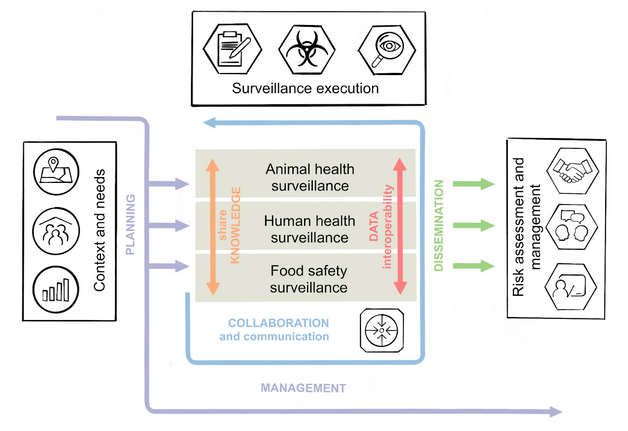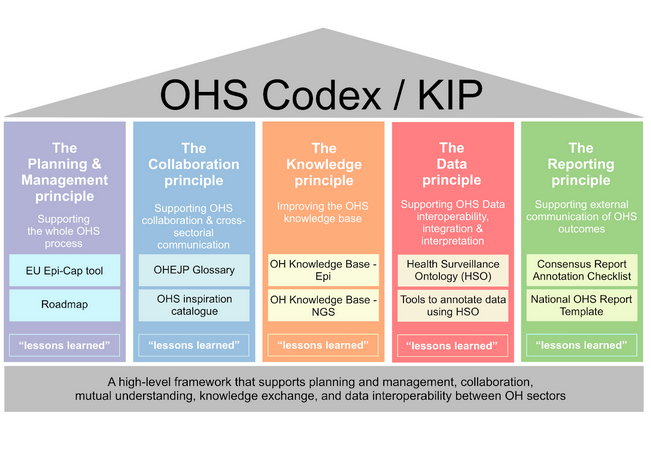OHS Codex/KIP
The purpose of the One Health Surveillance Codex: Knowledge Integration Platform (OHS Codex/KIP) is to provide users with guidance and resources, e.g. tools, technical solutions, guidance documents, that improve collaboration, mutual understanding and knowledge exchange between the different One Health Surveillance sectors. Moreover, it is thought to support better surveillance data integration and interpretation, along the One Health (OH) objective of improving health and well-being. The OHS Codex/KIP thereby supports the ambitions outlined in Chapter 3, 4, and 5.1 to 5.3 of the FAO, OIE and WHO document “Taking a Multisectoral, One Health Approach: A Tripartite Guide to Addressing Zoonotic Diseases in Countries” [1] (the so called Tripartite Zoonoses Guide) by proposing specific resources that support putting a true One Health approach (as described in the Tripartite Zoonoses Guide) into practice (Figure 1).

The OHS Codex/KIP aims at establishing a high-level framework that supports mutual understanding and information exchange between OHS sectors, which are requisite for integrated OHS data analyses. To bring this framework into “action”, the OHS Codex/KIP postulates a set of five high-level principles as well as a description of resources (e.g. tools, technical solutions, guidance documents) and example implementations supporting the adoption of each OHS Codex/KIP principles (Figure 2).

The OHS Codex/KIP aims at being generically applicable for surveillance purposes in all One Health sectors, including those that were not directly involved in the development of the OHS Codex/KIP e.g. the environmental sector. The OHS Codex/KIP intents also at being applicable to all countries, geographic areas and administrative levels. However, we recognize that the resources were created based on surveillance within the animal health, food safety and public health sector. Therefore, they may not consider every situation of One Health Surveillance (OHS) given the wide scope of countries and OHS contexts. It is also beyond the scope of the OHS Codex/KIP to create mechanisms or provide new structures for surveillance data sharing.
Users of this guide are invited to take the provided methods as practical examples that can be adapted to their contexts, needs, and requirements.
The OHS Codex/KIP can be accessed via: https://oh-surveillance-codex.readthedocs.io/en/latest/index.html
Publication
Filter, Matthias., Buschhardt, Tasja., Dórea, Fernanda., Lopez de Abechuco, Estibaliz., Günther, Taras., Sundermann, Esther M.; Gethmann, Jörn., Dups-Bergmann, Johanna., Lagesen, Karin., Ellis-Iversen, Johanne. (2021). One Health Surveillance Codex: promoting the adoption of One Health solutions within and across European countries. One Health, 12. DOI: https://doi.org/10.1016/j.onehlt.2021.100233